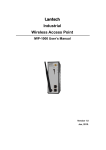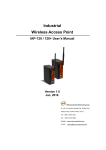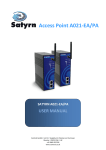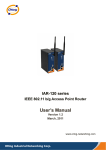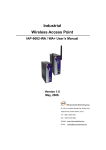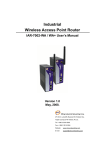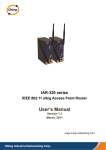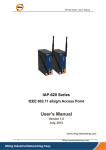Download User Manual
Transcript
Industrial Wireless Access Point APN-200/APN-200P User Manual Version 1.4 APN-200/APN-200P User’s Manual Table of Content 1 GETTING TO KNOW YOUR ACCESS POINT ............................................................................. 3 1.1 About the APN-200 Access Point ...................................................................................... 3 1.2 Software Features ............................................................................................................. 3 1.3 Hardware Features ........................................................................................................... 3 2 HARDWARE INSTALLATION ................................................................................................... 5 2.1 Installation AP on DIN-Rail ................................................................................................ 5 2.2 Wall Mounting Installation.................................................................................................. 6 3 HARDWARE OVERVIEW ........................................................................................................ 8 3.1 Front Panel........................................................................................................................ 8 3.2 Front Panel LEDs.............................................................................................................. 9 3.3 Bottom Panel................................................................................................................... 10 3.4 Rear Panel ...................................................................................................................... 10 4 CABLES AND ANTENNA ...................................................................................................... 12 4.1 Ethernet Cables .............................................................................................................. 12 4.1.1 4.2 100BASE-TX/10BASE-T Pin Assignments ................................................................. 12 Wireless Antenna ............................................................................................................ 13 5 MANAGEMENT INTERFACE .................................................................................................. 14 5.1 Explore APN-200/APN-200P........................................................................................... 14 5.1.1 AP-Monitor software ................................................................................................... 14 5.1.2 UPnP Equipment ........................................................................................................ 15 5.2 Configuration by Web Browser........................................................................................ 16 5.2.1 About Web-based Management ................................................................................. 17 5.2.1.1 5.2.2 Main Interface ................................................................................................... 17 Basic Setting .............................................................................................................. 18 5.2.2.1 Setting Operation Mode .................................................................................... 18 5.2.2.2 Setting WDS ..................................................................................................... 20 5.2.2.3 Setting Wireless ................................................................................................ 25 5.2.2.4 LAN Setting....................................................................................................... 28 5.2.2.5 Setting DHCP Server ........................................................................................ 30 5.2.3 Advanced Setting ....................................................................................................... 31 5.2.4.1 Wireless ............................................................................................................ 31 5.2.4.2 MAC Filter ......................................................................................................... 32 5.2.4.3 System Event.................................................................................................... 33 5.2.4 System Tools .............................................................................................................. 36 5.2.4.1 Administrator..................................................................................................... 36 1 APN-200/APN-200P User’s Manual 5.2.4.2 Date & Time ...................................................................................................... 37 5.2.4.3 Configuration..................................................................................................... 39 5.2.4.4 Firmware Upgrade ............................................................................................ 39 5.2.4.5 Miscellaneous ................................................................................................... 40 5.2.5 System Status ............................................................................................................ 41 5.2.5.1 System Info ....................................................................................................... 41 5.2.5.2 System Log ....................................................................................................... 41 5.2.5.3 Traffic Statistics ................................................................................................. 42 5.2.5.4 Wireless Clients ................................................................................................ 42 5.2.6 Online Help................................................................................................................. 42 6 TECHNICAL SPECIFICATIONS .............................................................................................. 44 2 APN-200/APN-200P User’s Manual 1 Getting to Know Your Access Point 1.1 About the APN-200 Access Point APN-200/APN-200P is a reliable IEEE802.11b/g WLAN 2 LAN port Access Point. It can be configured to operate in AP/Bridge/Repeater mode. You can configure APN-200/APN-200P by a Windows Utility or WEB interface via LAN port or WLAN interface. APN-200/APN-200P provides dual Ethernet ports in switch mode, so you can Daisy Chain to reduce the usage of Ethernet switch ports. APN-200P also provides PD feature on ETH2 which is fully compliant with IEEE802.3af P.O.E. specification. 1.2 Software Features High Speed Air Connectivity: WLAN interface support up to 54Mbps link speed connection High Security Capability: WEP/WPA/WPA2/802.1X/Radius/TKIP supported Support AP/Bridge/Repeater Mode Switch Mode Supported: Daisy Chain support to reduce usage of switch ports Secure Management by HTTPS and SSH Event Warning by Syslog, Email, SNMP Trap, Relay and Beeper 1.3 Hardware Features Fully Compliant with IEEE802.3af (Power Device at ETH2, APN-200P only) Redundant Power Inputs: 12~48 VDC on terminal block Operating Temperature: -10 to 70oC Storage Temperature: -35 to 75oC (-T Model) Operating Humidity: 5% to 95%, non-condensing 3 APN-200/APN-200P User’s Manual Casing: IP-30 10/100Base-T(X) Ethernet port Dimensions(W x D x H) : 52 mm(W)x 106 mm( D )x 144 mm(H) 4 APN-200/APN-200P User’s Manual 2 Hardware Installation 2.1 Installation AP on DIN-Rail Each AP has a Din-Rail kit on rear panel. The Din-Rail kit allows the AP to mount on the Din-Rail. Step 1: Slant the AP and mount the metal spring to Din-Rail. Metal Spring 5 APN-200/APN-200P User’s Manual Step 2: Push the AP toward the Din-Rail until you hear a “click” sound. 2.2 Wall Mounting Installation Each AP also supports a wall mount. A wall mount panel can be found in the package. The following steps show how to mount the AP on the wall: Step 1: Remove Din-Rail kit. 6 APN-200/APN-200P User’s Manual Step 2: Use 6 screws that can be found in the package to install the wall mount panel. The screws specifications are shown in the following two pictures. Pozidrive Step 3: Mount the AP on the wall. 7 APN-200/APN-200P User’s Manual 3 Hardware Overview 3.1 Front Panel The following table describes the labels on the APN-200/APN-200P. Port Description 10/100 RJ-45 fast 2 10/100Base-T(X) RJ-45 fast Ethernet ports support auto-negotiation. Ethernet ports Default Setting : Speed: auto Duplex: auto Flow control : disable P.O.E. PD Port ETH2 of APN-200P compliant with IEEE802.3af P.O.E. specifications ANT. Reverse SMA connector for external antenna. APN-200 APN-200P 8 APN-200/APN-200P User’s Manual 1. 2.4GHz antenna with typical 2.0dbi antenna gain. 2. LED for P.O.E. power and system status. When the P.O.E. power links, the green LED will be on. 3. LED for PWR1 and system status. When the PWR1 links, the green led will be on. 4. LED for PWR2 and system status. When the PWR2 links, the green led will be on. 5. LED for Fault Relay. When the fault occurs, the amber LED will be on. 6. 10/100Base-T(X) Ethernet ports. (APN-200P contains PD function of P.O.E.) 7. LED for Ethernet ports status. 8. LED for WLAN link status. 9. LED for WLAN signal strength. 3.2 Front Panel LEDs LED P.O.E. Color Green/Red Status Description Green On P.O.E. power connected. Indicates an IP conflict, or Red blinking DHCP or BOOTP server did not respond properly On DC power 1 activated. Indicates an IP conflict, or PWR1 Green/Red Red blinking DHCP or BOOTP server did not respond properly On PWR2 Green/Red DC power 2 activated. Indicates an IP conflict, or Red blinking DHCP or BOOTP server did not respond properly Fault Amber WLAN Green WLAN Strength Fault relay. Power failure or On Port down/fail. On WLAN activated. Blinking WLAN Data transmitted. WLAN signal strength. Green On 1<25%, 2<50%, 3<75%, 4<100% 10/100Base-T(X) Fast Ethernet ports 10Mbps Amber On Port link up at 10Mbps. 9 APN-200/APN-200P User’s Manual LNK/ACT 100Mbps LNK/ACT Green Blinking Data transmitted. On Port link up at 100Mbps. Blinking Data transmitted. 3.3 Bottom Panel The bottom panel components of APN-200/APN-200P are showed as below: 1. Terminal block includes: PWR1, PWR2 (12 ~ 48V DC) and Relay output (1A@24VDC). 2. Reset bottom. Push the bottom 3 seconds for reset; 5 seconds for factory default. PWR1, PWR2 (12-48V DC) and Reset Button Relay output (1A@24VDC). 3.4 Rear Panel The rear panel components of APN-200/APN-200P are showed as below: 1. Screw holes for wall mount kit. 2. Din-Rail kit 10 APN-200/APN-200P User’s Manual 11 APN-200/APN-200P User’s Manual 4 Cables and Antenna 4.1 Ethernet Cables The APN-200/APN-200P switches have standard Ethernet ports. According to the link type, the switches use CAT 3, 4, 5,5e UTP cables to connect to any other network device (PCs, servers, switches, routers, or hubs). Please refer to the following table for cable specifications. Cable Types and Specifications Cable Type 10BASE-T Cat. 3, 4, 5 100BASE-TX Cat. 5 100-ohm UTP 1000BASE-TX 100-ohm Cat. 5/Cat. 5e 100-ohm UTP Max. Length Connector UTP 100 m (328 ft) RJ-45 UTP 100 m (328 ft) RJ-45 UTP 100 m (328ft) RJ-45 4.1.1 100BASE-TX/10BASE-T Pin Assignments With 100BASE-TX/10BASE-T cable, pins 1 and 2 are used for transmitting data, and pins 3 and 6 are used for receiving data. RJ-45 Pin Assignments Pin Number Assignment 1 TD+ 2 TD- 3 RD+ 4 Not used 5 Not used 6 RD- 7 Not used 12 APN-200/APN-200P User’s Manual 8 Not used The APN-200/APN-200P switches support auto MDI/MDI-X operation. You can use a straight-through cable to connect PC and switch. The following table below shows the 10BASE-T/ 100BASE-TX MDI and MDI-X port pin outs. MDI/MDI-X pins assignment Pin Number MDI port MDI-X port 1 TD+(transmit) RD+(receive) 2 TD-(transmit) RD-(receive) 3 RD+(receive) TD+(transmit) 4 Not used Not used 5 Not used Not used 6 RD-(receive) TD-(transmit) 7 Not used Not used 8 Not used Not used Note: “+” and “-” signs represent the polarity of the wires that make up each wire pair. 4.2 Wireless Antenna A 2dbi 2.4GHz antenna is used for APN-200/APN-200P and connected with a reversed SMA connector. 13 APN-200/APN-200P User’s Manual 5 Management Interface 5.1 Explore APN-200/APN-200P 5.1.1 AP-Monitor software Each model contains the AP-Monitor software, to find and configure the APN-200/APN-200P on local area network. Step 1: Open the AP-Monitor and click “Refresh list”, the AP devices will show on the list. Step 2: Choose your access point, and it will show the AP settings. Simultaneously, you can set the AP’s IP address. 14 APN-200/APN-200P User’s Manual Step 3: Click “Access via web” button, it will go to web page. 5.1.2 UPnP Equipment Step 1: To check whether the UPnP UI of the computer is connected to the APN-200/APN-200P, go to Control Panel>Add or Remove Programs>Windows Components Wizard>Networking Servers>UPnP User Interface and click on the UPnP User Interface. Step 2: At the lower right corner of the computer, you will find a sign of the UPnP equipment. 15 APN-200/APN-200P User’s Manual Step 3: Click the sign of the UPnP equipment, then you will find the UPnP equipment in the network neighborhood. Step 4: Right click the UPnP equipment to choose “Properties.” Step 5: Right click the UPnP equipment or double click the UPnP equipment to transfer; it will go to the web page. 5.2 Configuration by Web Browser This section introduces the configuration by Web browser. 16 APN-200/APN-200P User’s Manual 5.2.1 About Web-based Management Each AP contains an embedded HTML web site residing in flash memory. With its advanced management features, it allows you to manage the AP from anywhere on the network through a standard browser such as Microsoft Internet Explorer. The Web-Based Management supports Internet Explorer 5.0 and above. Note: By default, IE5.0 or later version does not allow Java Applets to open sockets. You need to explicitly modify the browser setting in order to enable Java Applets to use network ports. Through the front section’s information, enter your user name (admin) and your password (admin), then click Ok to continue. Login screen For security reasons, we strongly suggest you change the password. Click on System ToolsÆAdministrator and modify the password. 5.2.1.1 Main Interface The Home screen will appear. Please click “Run Wizard” to go to the HomeÆSetup Wizard page to install the AP. 17 APN-200/APN-200P User’s Manual Main interface 5.2.2 Basic Setting 5.2.2.1 Setting Operation Mode Operation mode interface The following table describes the labels in this screen. Label Description Bridge This mode provides Static LAN-to-LAN Bridging functionality. The static LAN-to-LAN bridging function is supported through Wireless Distribution System (WDS). AP-Client The AP-Client function provides a 1-to-N MAC address mapping 18 APN-200/APN-200P User’s Manual mechanism such that multiple stations behind the AP can transparently connect to the other AP even if they don't support WDS. AP This mode provides Access Point services for other wireless clients. In any mode, the APN-200/APN-200P forwards packet between its Ethernet interface and wireless interface for wired hosts on the Ethernet side, and wireless hosts on the wireless side. Access Point Mode .AP mode provides wireless service for other wireless clients .POE supported AP Client Mode .AP Client Mode provide a 1-to-N MAC address mapping mechanism such that multiple stations behind the AP can transparently connect to other APs even if they don’t support WDS 19 APN-200/APN-200P User’s Manual Bridge Mode .Bridge mode provide static LAN-to-LAN Bridging functionality. The static LAN-to-LAN bridging function is supported through wireless distribution system (WDS) 5.2.2.2 Setting WDS This type of wireless link is established between two IEEE 802.11 access points. Wireless packets transmitted along the WDS link comply with the IEEE 802.11 WDS (Wireless Distribution System) format at the link layer. 20 APN-200/APN-200P User’s Manual The following table describes the labels in this screen. Label Description WDS Mode This mode provides Static LAN-to-LAN Bridging functionality. The static LAN-to-LAN bridging function is supported through Wireless Distribution System (WDS). Encryption Type Select the type of security for your wireless network WDS Key Fill in the encryption key when Encryption Type is TKIP or AES. Peer MAC Set the Mac address(es) of other access point(s). Address choose “Enable”. Simultaneity, If linked with WDS mode, they should obey the following rules: 1. IP Addresses should set different IPs in the same subnet. 2. All AP’s DHCP Server should be disabled. 3. WDS should be enabled. 4. Each AP should have the same setting except ‘Peer Mac Address’ set to the other’s Mac addresses 21 APN-200/APN-200P User’s Manual 5. WEP Key and Channel should be the same. WDS – Restricted Mode The peer WDS APs are according to the MAC address listed in "Peer Mac Address" fields. WDS – Bridge Mode 22 APN-200/APN-200P User’s Manual The working principle of the Bridge Mode is as follows: In the figure, the AP behaves as a standard bridge that forwards traffic between WDS links (links that connect to other AP/wireless bridges) and an Ethernet port. As a standard bridge, the AP learns MAC addresses of up to 64 wireless or 128 total wired and wireless network devices, which are connected to their respective Ethernet ports. Only data destined for stations which are known to reside on the peer Ethernet link, multicast data or data with unknown destinations need to be forwarded to the peer AP via the WDS link. WDS – Repeater Mode 23 APN-200/APN-200P User’s Manual The working principle of the Repeater Mode is as follows: In the figure, Repeater is used to extend the range of the wireless infrastructure by forwarding traffic between associated wireless stations and another repeater or AP connected to the wired LAN. 24 APN-200/APN-200P User’s Manual 5.2.2.3 Setting Wireless The following table describes the labels in this screen. Label Description SSID Service Set Identifier Default is the default setting. The SSID is a unique name that identifies a network. All devices on the network must share the same SSID name in order to communicate on the network. If you change the SSID from the default setting, input your new SSID name in this field. Channel Channel 6 is the default channel, input a new number if you want to change the default setting. All devices on the network must be set to the same channel to communicate on the network. Security options Select the type of security for your wireless network at Security Type: None: Select for no security. WEP: Select for security. WPA-PSK/WPA2-PSK: Select for WPA-PSK or WPA2-PSK without a RADIUS server. WPA/WPA2: Select for WPA (Wi-Fi Protected Access) authentication in conjunction with a RADIUS server. Security Type – None No security protection on your wireless LAN access. 25 APN-200/APN-200P User’s Manual Security Type – WEP 1. Security Type: Select WEP 2. WEP Encryption: Select 64 Bit or 128 Bit WEP encryption. 3. Key Type: Select ASCII or Hex key type. 4. Default Key Index: Select one of the keys to be the active key. 5. Key 1-4: Input up to four encryption keys. ASCII (American Standard Code for Information Interchange) is a code for representing English letters as numbers from 0-127. Hex digits consist of the numbers 0-9 and the letters A-F. Security Type – WPA-PSK/WPA2-PSK 26 APN-200/APN-200P User’s Manual 1. Security Type: Select WPA-PSK/WPA2-PSK. 2. Encryption Type: Select TKIP or AES encryption. 3. Share Key: Enter your password. The password can be between 8 and 64 characters. Security Type – WPA /WPA2 1. Security Type: Select WPA/WPA2 2. Radius Server IP: Enter the IP address of the RADIUS Server. 3. Port: Enter the RADIUS port (1812 is default). 4. Shared Secret: Enter the RADIUS password or key. RADIUS (Remote Authentication Dial-in User Service) is the industrial standard agreement, and it is used to provide an identify verification. The Radius customer (is usually a dial-in server, VPN server or wireless point) sends your identification to the Radius server by Radius news. The Radius server validates the request of the Radius customer. The principle of the Radius server is shown in the following pictures: 27 APN-200/APN-200P User’s Manual 5.2.2.4 LAN Setting The Basic SettingÆLAN Setting page mainly sets IP addresses for LAN interface. To access the AP, a valid IP address of your LAN should be specified to the LAN interface. The default IP setting is DHCP server (Obtain an IP address automatically). The following table describes the labels in this screen. Label Description 28 APN-200/APN-200P User’s Manual Obtain an IP address Select this option if you would like to have an IP address automatically assigned to the APN-200/APN-200P by DHCP server in your network automatically Use the following IP address Select this option if you are manually assigning an IP address. IP Address: There is a default IP address in the AP, and you can input a new IP address. Subnet Mask: 255.255.255.0 is the default Subnet Mask. All devices on the network must have the same subnet mask to communicate on the network. Default Gateway: Enter the IP address of the router in your network. Obtain DNS server address This option is selected by DHCP server. automatically Use the following DNS server addresses This option is selected by manually set Preferred DNS: There is a default DNS server, and you can input another new DNS server. Alternate DNS: There is a default DNS server, and you can input another new DNS server. 29 APN-200/APN-200P User’s Manual 5.2.2.5 Setting DHCP Server The following table describes the labels in this screen. Label Description DHCP Server Enable or Disable the DHCP Server function. Enable – the switch will be the DHCP server on your local network Start IP Address The dynamic IP assign range. Low IP address is the beginning of the dynamic IP assigns range. For example: dynamic IP assign range is from 192.168.1.100 to 192.168.1.200. 192.168.1.100 will be the Start IP address. End IP Address The dynamic IP assign range. High IP address is the end of the dynamic IP assigns range. For example: dynamic IP assign range is from 192.168.1.100 to 192.168.1.200. 192.168.1.200 will be the End IP address Lease Time It is the time period that system will reset the dynamic IP assignment to (Hour) ensure the dynamic IP will not been occupied for a long time or the server doesn’t know that the dynamic IP is idle. DHCP Clients List List the devices on your network that are receiving dynamic IP addresses from the APN-200/APN-200P. 30 APN-200/APN-200P User’s Manual 5.2.3 Advanced Setting 5.2.4.1 Wireless The following table describes the labels in this screen. Label Description Beacon Interval The default value is 100. The Beacon Interval value indicates the frequency interval of the beacon. A beacon is a packet broadcast by the AP to synchronize the wireless network. 50 is recommended in poor reception. DTIM Interval The default value is 1. This value, between 1 and 255 milliseconds, indicates the interval of the Delivery Traffic Indication Message (DTIM). A DTIM field is a countdown field informing clients of the next window for listening to broadcast and multicast messages. When the AP has buffered broadcast or multicast messages for associated clients, it sends the next DTIM with a DTIM Interval value. Its clients hear the beacons and awaken to receive the broadcast and multicast messages. Fragmentation This value should remain at its default setting of 2346. The range is Threshold 256-2346 bytes. It specifies the maximum size for a packet before data is fragmented into multiple packets. If you experience a high packet error rate, you may slightly increase the Fragmentation Threshold. Setting the Fragmentation Threshold too low may result in 31 APN-200/APN-200P User’s Manual poor network performance. Only minor modifications of this value are recommended. RTS Threshold This value should remain at its default setting of 2347. The range is 0-2347 bytes. Should you encounter inconsistent data flow, only minor modifications are recommended. If a network packet is smaller than the preset RTS threshold size, the RTS/CTS mechanism will not be enabled. The AP sends Request to Send (RTS) frames to a particular receiving station and negotiates the sending of a data frame. After receiving an RTS, the wireless station responds with a Clear to Send (CTS) frame to acknowledge the right to begin transmission. Xmit Power This value ranges from 1 - 100 percent, default value is 100 percent. A safe increase of up to 60 percent would be suitable for most users. Higher power settings are not recommended for users due to excess heat generated by the radio chipset, which can affect the life of the AP. Wireless Network If you have Wireless-G and 802.11b devices in your network, then Mode keep the default setting, BG Mixed mode. If you have only Wireless-G devices, select G Mode. If you would like to limit your network to only 802.11b devices, then select B Mode. Transmission The default setting is Auto. The range is from 1 to 54Mbps. The Rate rate of data transmission should be set depending on the speed of your wireless network. You can select from a range of transmission speeds, or keep the default setting, Auto, to have the AP automatically use the fastest possible data rate and enable the Auto-Fallback feature. Auto-Fallback will negotiate the best possible connection speed between the AP and a wireless client. Values are Long and Short, default value is Long. If your wireless Preamble device supports the short preamble and you are having trouble getting it to communicate with other 802.11b devices, make sure that it is set to use the long preamble SSID Broadcast When wireless clients survey the local area for wireless networks to associate with, they will detect the SSID broadcast by the AP. To broadcast the AP SSID, keep the default setting, Enable. If you do not want to broadcast the AP SSID, then select Disable. 5.2.4.2 MAC Filter Use Advanced Setting Æ MAC Filters to allow or deny wireless clients, by their MAC 32 APN-200/APN-200P User’s Manual addresses, from accessing the APN-200/APN-200P. You can manually add a MAC address or select the MAC address from Connected Clients that are currently connected to the AP. The following table describes the labels in this screen. Label Description MAC Filter Enable or disable the function of MAC filter. MAC address allowed or denied option is selected by you. MAC Filter List This list will display the MAC addresses that are in the selected filter. Connected This list will display the wireless MAC addresses that linked with AP. Clients MAC Address MAC addresses need to be added to or clear from MAC filter list. Apply Click Apply to set the configurations. 5.2.4.3 System Event When the AP event is triggered, the notification procedure will be performed according to the type of the event. Which notification would be performed depends on the selection of corresponding option in the Advanced Setting Æ System Event page. 33 APN-200/APN-200P User’s Manual System events record the activities of the AP system. When the settings change, the event will be sent to administrator by email. A trap will also be sent to SNMP server. The Syslog will record the event locally and may send the log remotely to a Syslog server. If serious event occurred, such as the power failure or link down, the fault LED will be switched on as warning. Email Settings The following table describes the labels in this screen. 34 APN-200/APN-200P User’s Manual Label SMTP Server Description Simple Message Transfer Protocol, enter the backup host to use if primary host is unavailable while sending mail by SMTP server. Server Port E-mail Address 1-4 Specify the port where MTA can be contacted via SMTP server. Inputs specify the destination mail address. SNMP Settings The following table describes the labels in this screen. Label SNMP Agent Description SNMP (Simple Network Management Protocol) Agent is a service program that runs on the access point. The agent provides management information to the NMS by keeping track of various operational aspects of the AP system. Turn on to open this service and off to shutdown it. SNMP Trap Specify the IP of trap server, which is the address to which it will send Server 1-4 traps AP generates. Community Community is essentially password to establish trust between managers and agents. Normally "public" is used for read-write community. SysLocation Specify sysLocation string. 35 APN-200/APN-200P User’s Manual SysContact Specify sysContact string. Syslog Server Settings The following table describes the labels in this screen. Label Description Syslog Server IP Not only the syslog keeps the logs locally, it can also log to remote server. Specify the IP of remote server. Leave it blank to disable logging remotely. Syslog Server Port Specify the port of remote logging. Default port is 514. 5.2.4 System Tools 5.2.4.1 Administrator In this page, you can change the username and password. The new password must be typed twice to confirm (the default Name and Password is “admin” and “admin”). 36 APN-200/APN-200P User’s Manual The following table describes the labels in this screen. Label Description Old Name This field displays the old login name. It's read only. The default value of login name is "admin". Old Password Before making a new setting, you should provide the old password for a verify check. Acceptable inputs of this field contains '0-9', 'a-z', 'A-Z' and must be between 0 to 15 characters in length. The factory default value of login password is null. Enter a new login name. Acceptable inputs of this field contains '0-9', New Name 'a-z', 'A-Z' and must be between 1 to 15 characters in length. This field can not accept null input. New Password Enter a new login password. Acceptable inputs of this field contains '0-9', 'a-z', 'A-Z' and must be between 0 to 15 characters in length. Confirm New Retype the password to confirm it. Acceptable inputs of this field Password contains '0-9', 'a-z', 'A-Z' and must be between 0 to 15 characters in length. Web Protocol Choose on the protocol for web. The default value is HTTP, if you want the web pages’ security is better, choose the HTTPS protocol. Port Corresponding to the Web protocol, there is a default port (HTTP: 80, HTTPS: 443). And you can enter another number which should be in range of 1-65535. HTTPS (HTTP over SSL) is a Web protocol developed by Netscape and built into its browser that encrypts and decrypts user page requests as well as the pages that are returned by the Web server. 5.2.4.2 Date & Time In this page, set the date & time of the device. The correct date & time will be helpful for logging of system events. A NTP (Network Time Protocol) client can be used to synchronize date & time with NTP server. 37 APN-200/APN-200P User’s Manual The following table describes the labels in this screen. Label Description Local Date Set local date manually. Local Time Set local time manually. Time Zone Select the time zone manually Get Current Date Click this button; you can set the time from browser. & Time from Browser NTP Enable or disable NTP function to get the time from the NTP server. NTP Server 1 The initial choice about NTP Server. NTP Server 2 The second choice about NTP Server. Synchronize Set the time, and the AP’s time synchronize with the NTP Server at the time 38 APN-200/APN-200P User’s Manual 5.2.4.3 Configuration The following table describes the labels in this screen. Label Description Download The current system settings can be saved as a file onto the local hard configuration drive. Upload The saved file or any other saved setting file can be uploaded back on configuration the AP. To reload a system settings file, click on Browse to browse the local hard drive and locate the system file to be used. Click Upload when you have selected the file to be loaded back onto the AP. Restore Default You may also reset the APN-200/APN-200P back to factory settings by Settings clicking on Restore Default Settings. Make sure to save the unit’s settings before clicking on this button. You will lose your current settings when you click this button. 5.2.4.4 Firmware Upgrade New firmware may provide better performance, bug fixes or more functions. To upgrade, 39 APN-200/APN-200P User’s Manual you need a firmware file correspond to this AP model. It will take several minutes to upload and upgrade the firmware. After the upgrade is done successfully, the access point will reboot and get revalidated. Important Notice: DO NOT POWER OFF THE AP OR PRESS THE RESET BUTTON WHILE THE FIRMWARE IS BEING UPGRADED. 5.2.4.5 Miscellaneous If you want restart the access point through the Warm Reset, click Restart Now to restart the AP. 40 APN-200/APN-200P User’s Manual 5.2.5 System Status 5.2.5.1 System Info This page displays the current information for the APN-200/APN-200P. It will display model, as well as firmware version, Ethernet, Wireless info and device time. 5.2.5.2 System Log The system log tracks the important events and setting changes of the AP. rebooted, the logs are automatically cleared. Click the button 'Refresh' to refresh the page. Click the button 'Clear' to clear the log entries. 41 If the AP is APN-200/APN-200P User’s Manual 5.2.5.3 Traffic Statistics This page displays the network traffic statistics for both received and transmitted packets through the Ethernet port and wireless connections associated with the AP. Simultaneously, the traffic counter will reset by the device rebooting. 5.2.5.4 Wireless Clients This page of the list displays the Mac Address of the wireless clients connected. Current TX Rate is corresponding to the Transmission Rate in the Advanced Setting Æ Wireless pages. 5.2.6 Online Help Click on any item in the Online Help screen for more information. 42 APN-200/APN-200P User’s Manual 43 APN-200/APN-200P User’s Manual 6 Technical Specifications LAN Interface RJ45 Ports 2 x 10/100Base-T(X), Auto MDI/MDI-X Protection Built-in1.5KV magnetic isolation Protocols ICMP, IP, TCP, UDP, DHCP, BOOTP, ARP/RARP, DNS, SNMP MIB II, HTTPS, SSH, SNMPV1/V2, Trap, Private MIB P.O.E. PD Present at ETH2 of APN-200P Power Device (IEEE802.3af): IEEE 802.3af compliant input interface Power consumption: 8Watts max. Over load & short circuit protection Isolation Voltage: 1000 VDC min. Isolation Resistance: 108 ohms min WLAN Interface Operating Mode AP/Bridge/Repeater Antenna Connector Reverse SMA Radio Frequency Type DSSS Modulation IEEE802.11b: CCK, DQPSK, DBPSK IEEE802.11g: OFDM with BPSK, QPSK, 16QAM, 64QAM Frequency Band America/FCC: 2.412~2.462 GHz (11channels) Europe CE/ETSI: 2.412~2.472 GHz (13channels) Transmission Rate IEEE802.11b: 1/2/5.5/11 Mbps IEEE802.11g: 6/9/12/18/24/36/48/54 Mbps Transmit Power IEEE802.11b/g: 18dBm Receiver Sensitivity -81dBm@11Mbps, PER< 8%; 44 APN-200/APN-200P User’s Manual -64dBm@54Mbps, PER< 10% Encryption Security WEP: (64-bit, 128-bit key supported) WPA: WPA2:802.11i (WEP and AES encryption) PSK (256-bit key pre-shared key supported) 802.1X and Radius supported TKIP encryption Wireless Security SSID broadcast disable LED Indicators PWR 1(2) (P.O.E., APN-200P) / Ready: 1) Red On: Power is on and booting up. Red Blinking: Indicates an IP conflict, or DHCP or BOOTP server did not respond properly. 2) Green On: Power is on and functioning normally. Green Blinking: Located by Administrator. ETH1 (2) Link / ACT: Orange ON/Blinking: 10 Mbps Ethernet Green ON/Blinking: 100 Mbps Ethernet WLAN Link/ACT: Green: Link, Orange: Poor signal WLAN Strength:1<25%, 2<50%, 3<75%, 4<100% Fault: WLAN link down (Red) Power Requirements Power Input Voltage PWR1/2: 12 ~ 48VDC in 6-pin Terminal Block Reverse Polarity Protection Present Power Consumption 6 Watts Max Environmental Operating Temperature -10 to 70oC Storage Temperature -35 to 75oC Operating Humidity 5% to 95%, non-condensing Mechanical Dimensions(W x D x H) 52 mm(W)x 106 mm( D )x 144 mm(H) Casing IP-30 protection Regulatory Approvals 45 APN-200/APN-200P User’s Manual Regulatory Approvals CE class A RoHS EMS EN61000-4-2 (ESD), EN61000-4-3 (RS), EN61000-4-4 (EFT), EN61000-4-5 (Surge), Level 3, EN61000-4-6 (CS), Level 3 Shock IEC60068-2-27 Free Fall IEC 60068-2-32 Vibration IEC 60068-2-6 46















































